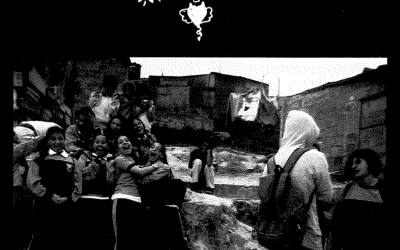Breaking the Cycle of Violence
Through Education
Why do eight-year-olds resort to such violent threats to solve an otherwise ordinary dispute among classmates? Why didn’t they see other alternatives? How come incidents like this one—and much worse—occur daily in many schools in Colombia and frequently escalate rapidly? We consider that high levels of violence in the society where these boys and girls are growing up are a significant factor. But at the same time, we think that challenging the negative influence of a violent social context and develop alternative ways of dealing with life conflicts is possible. And this is exactly what several educational programs in Colombia are trying to accomplish.
Colombia continues to be one of the most violent countries in the world. Most of its violence is not directly related to the armed conflict but to common types of violence such as fights, revenge killings and settling of scores between individuals or delinquent groups. However, the decades-old political armed conflict and the extremely profitable illegal drug trade business may have had an indirect effect on these more common types of violence. In fact, several have demonstrated a clear spatial correspondence between levels of common violence and the presence of armed groups and/or drug trafficking businesses. Somehow the presence of political violence and organized crime creates a fertile environment for more common types of violence.
One of the mechanisms through which political violence and drug-related crime may have indirectly contributed to the high violence levels in Colombia is from what children have been learning from their social context during these years. Other mechanisms—often reinforcing these early childhood lessons—seem to be the undermining of the judicial system, the availability of weapons, and the diffusion of a know-how related to the organization of criminal activities. Children who grow up a violent environment may learn that violence is a legitimate and effective way to reach their goals and to deal with their conflicts. They have many opportunities to acquire the skills necessary to use violence in their daily life, as Alberto’s classmates demonstrate. And as children grow older, they are likely to contribute to the violence of their social contexts, therefore closing a cycle of violence: children experiencing and observing violence in context → learning aggressive behaviors → sustaining violence in context. Indeed, several international studies are showing an increased risk of children developing aggressive behaviors by growing up in communities where violence is widespread. Furthermore, since aggressive behaviors are highly stable throughout life, those children are likely to contribute to sustain (or increase) the violence in their communities. That is, if nothing is done to prevent the cycle of violence from occurring.
The cycle of violence needs to be broken in several places. Different policies can be implemented to try to decrease political violence, organized crime and common violence in the communities in the first place. Many public and non-governmental institutions are working at that level and in some cities, like Bogotá, the results have been impressive. However, even if the levels of violence in society and in local communities remain high, the cycle of violence can be broken by trying to affect its mechanisms of reproduction. In particular, the educational system may be able to compensate for part of what children are learning from their environment. For example, children can be taught in schools to de-legitimize violence as a way to reach goals. Good teaching can help students think of the consequences of actions beyond their immediate effects, understand the perspectives of others involved in the conflicts and control the impulse to impose violently one’s own way. At the same time, students can learn and have opportunities to practice alternative non-violent ways of dealing with their interpersonal disputes. Several educational programs around Colombia are doing just that, although from different perspectives (see for example the initiatives described by Leonel Narváez and Rodrigo Guerrero, pages xx and yy). In the following paragraphs, we briefly present two innovative programs in Bogotá that, although in their early phases, are already providing interesting lessons.
One of these initiatives is the “Prueba de Comprensión y Sensibilidad Ciudadana” of the Department of Education of Bogotá. This is a city wide program for the assessment of citizenship understanding and sensibility of school-age students. In 1998 the Department of Education started a program to assess the development of basic competencies in students in elementary and middle school. It initially focused on language literacy and math, but it soon extended to incorporate citizenship as a crucial area. A set of instruments were designed or adapted by an interdisciplinary team during four years of research and experimental applications. (Both authors of this article are part of this team. Angela Bermudez was, together with Rosario Jaramillo, co-director of the program from 1998 to 2001 and currently serves as consultant, and Enrique Chaux was recently involved).
Three basic dimensions of citizenship understanding and sensibility are assessed:
- The student’s knowledge about the basic principles, institutions and procedures of a democratic government and instances for the participation of civil society;
- The student’s attitudes and opinions regarding diverse citizenship issues (i.e.: political participation, trust in institutions, law, violence and war, informal and formal agreements);
- The student’s development of social and ethical competencies (moral judgment of justice, perspective taking and coordination, and the consistency in the judgment of one’s own stances and those of opposite parties in a conflict, reflective control of aggression and violence).
Interesting information about students’ understanding of citizenship has already emerged from the experimental applications carried out in past years. However, the a new base-line application of this study will take place in February 2003 with a sample of about 12,000 students in 7th, 9th and 11th grade in public and private schools from across all city districts.
In the context of this program, Bogotá’s Department of Education and the Harvard Graduate School of Education recently agreed on a formal academic collaboration. . The jointly-sponsored Study of Citizenship Understanding and Sensibility will incorporate the “Relationship Questionnaire” (Rel-Q), designed by Professors Robert Selman and Lynn Schultz from the Group for the Study of Interpersonal Development. The Rel-Q is a composite measure to assess the social competencies of students from 4th(ages 8-9) through 12th grade (ages 16-18). Social competence is defined by this group as ‘relationship maturity’, or the capacity for forming and maintaining healthy relationships with other people. Based on the assessment of the central ability to differentiate and coordinate the social perspectives of self and others, the Rel-Q informs about the development of three components of social competence: (1) student’s knowledge and understanding about the nature of general interpersonal relationships, (2) student’s skills in the intimacy and autonomy strategies used to deal with interpersonal conflicts (that is, sustaining close relationships and connection while at the same time asserting one’s own needs and perspectives), and (3) the personal meaning students give to particular personal relationships and their emotional investment in them. As a whole, the Rel–Q also provides an interesting assessment of the school’s social climate that can influence student’s development.
The general purpose of this Program is to assess students’ development to provide feedback and support to teachers, schools, districts and central policy-makers on how to improve the corresponding pedagogical practices. For this reason, results will be reported about the schools and districts as a whole and not about individual students. In this sense, it is not an exam that students pass or fail. The results of these assessments will hopefully provide crucial information to those working on school institutional projects, curriculum development, teacher education programs and educational policies. One example of the potential beneficiaries of the results obtained with the “Prueba de Comprensión y Sensibilidad Ciudadana” is the other initiative we want to describe in this article.
Two years ago, Universidad de los Andes, a prestigious private university in Colombia, joined efforts with the elite private schools Nogales, San Carlos and Nueva Granada and took over the academic and administrative leadership of five newly created public schools located in the poorest areas in Bogotá. This project is part of a larger program led by the Department of Education of Bogotá which has handed over the administration of new public schools to private schools, universities and not-for-profit organizations. This program enables institutions with a nationally recognized knowledge about education to transfer that knowledge to public schools in underprivileged areas of Bogotá. And it seems to be working. Many agree that students are getting a high-quality education that they would not get otherwise.
With the support of a business foundation called Genesis led by Harvard graduate Claudia Ordoñez, more than 20 professors, researchers and graduate students from the Universidad de los Andes, and high school teachers from Nogales, San Carlos and Nueva Granada are working together with the public school teachers to construct and try an innovative curriculum. One of us (Enrique Chaux) is leading within this project an area called Democracy, Moral Development and Peaceful Relationships (Convivencia, in Spanish). The goal is to construct guidelines, examples, and methodologies that could be helpful to teachers from all academic areas working with students from all grades.
Some examples of projects carried by graduate students and researchers will illustrate parts of this innovative effort. Marcela Ossa, inspired by Boston’s Facing History and Ourselves program, is designing lessons to teach about Colombia’s history of political violence in ways that directly relate that history to the daily life of students. Lina Saldarriaga is analyzing how math could be taught in ways that promote cooperation and peaceful relationships among the students. Laura Vega is using children’s literature as a means to promote empathy, interpersonal communication and conflict resolution skills among the students in ways similar to Boston’s “Voices of Love and Freedom” program (both “Facing History and Ourselves” and “Voices of Love and Freedom” have institutional partnerships with Harvard’s Graduate School of Education and are planning ways to work in Colombia). Diana Trujillo is analyzing how arts and music education can become a way to promote caring about the self and others. Fernando Mejía is analyzing how examples of moral dilemmas created by Harvard’s professor Larry Kohlberg may be useful to help students analyze, make decisions and reach consensus about difficult real-life situations. Berta Cecilia Daza is constructing ways in which caring for self, others, animals and the environment could be promoted in science classes. The idea is that all academic areas can provide opportunities for the promotion of democratic participation, moral development, caring, cooperation, and peaceful and harmonious relationships. If this idea works, it is likely that these lessons will be useful to many other schools in Colombia.
It is difficult to determine exactly what led children like Alberto’s classmates to consider violent means to reach their goals. To be sure, violence in Colombia will not be reduced if the only thing we do is create the kind of innovative educational programs described here. But these programs can definitively make a contribution. And maybe, in the long term, that can lead to fewer adults using violence in the larger communities. We would have taken a step towards breaking the cycle of violence in Colombia.
Angela Bermudez is currently a doctoral student at the Harvard Graduate School of Education. Both Chaux and Bermudez have been active in the Harvard-MIT Colombian Colloquium.
Related Articles
Editor’s Letter
This is a celebratory issue of ReVista. Throughout Latin America, LGBTQ+ anti-discrimination laws have been passed or strengthened.
Editor’s Letter: Colombia
When I first started working on this ReVista issue on Colombia, I thought of dedicating it to the memory of someone who had died. Murdered newspaper editor Guillermo Cano had been my entrée into Colombia when I won an Inter American…
Photoessay: Shooting for Peace
Photoessay: Shooting for PeacePhotographs By The Children of The Shooting For Peace Project As this special issue of Revista highlights, Colombia’s degenerating predicament is a complex one, which needs to be looked at from new perspectives. Disparando Cámaras para la...



